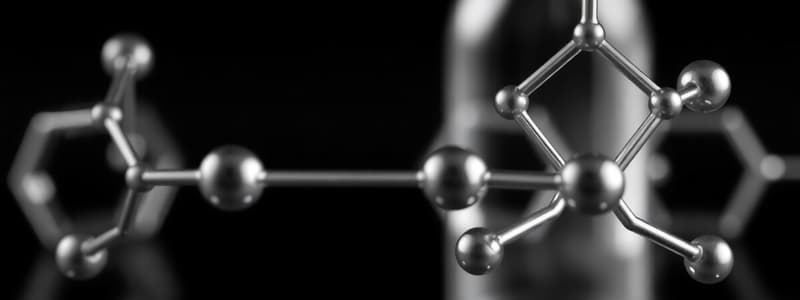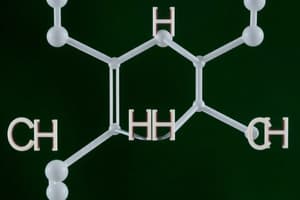Podcast
Questions and Answers
What distinguishes stereoisomers from constitutional isomers?
What distinguishes stereoisomers from constitutional isomers?
- Stereoisomers have different functional groups.
- Stereoisomers have different molecular formulas.
- Stereoisomers differ only in spatial orientation. (correct)
- Stereoisomers have different IUPAC names.
Which of the following statements about geometrical isomers is correct?
Which of the following statements about geometrical isomers is correct?
- Geometrical isomers can freely rotate around the pi-bond.
- Geometrical isomers differ in the type of functional groups present.
- Cis and trans isomers differ in their spatial arrangement. (correct)
- Geometrical isomers always have different molecular formulas.
In the context of 2-butene, which of the following correctly identifies the cis isomer?
In the context of 2-butene, which of the following correctly identifies the cis isomer?
- Methyl groups on opposite sides of the double bond.
- An isomer with a different molecular formula.
- The isomer with a higher boiling point.
- Methyl groups on the same side of the double bond. (correct)
Which type of isomerization involves molecules with the same IUPAC name but different arrangements in space?
Which type of isomerization involves molecules with the same IUPAC name but different arrangements in space?
Why are trans isomers generally more stable than cis isomers?
Why are trans isomers generally more stable than cis isomers?
Which term describes the specific three-dimensional arrangement of atoms in stereoisomers?
Which term describes the specific three-dimensional arrangement of atoms in stereoisomers?
What is the implication of the π-bond in alkenes regarding molecular rotation?
What is the implication of the π-bond in alkenes regarding molecular rotation?
Which statement best describes the relationship between cis and trans isomers?
Which statement best describes the relationship between cis and trans isomers?
What determines the D or L configuration in carbohydrates?
What determines the D or L configuration in carbohydrates?
Which statement about Fischer projections is correct?
Which statement about Fischer projections is correct?
In the context of amino acids, what differentiates D and L enantiomers?
In the context of amino acids, what differentiates D and L enantiomers?
How are the absolute configurations designated in the R/S system?
How are the absolute configurations designated in the R/S system?
What is the significance of the terms (+)- and (-)- in relation to stereochemistry?
What is the significance of the terms (+)- and (-)- in relation to stereochemistry?
Which of the following accurately identifies a D-configuration molecule?
Which of the following accurately identifies a D-configuration molecule?
In Fischer projections, where is the carboxyl group typically placed?
In Fischer projections, where is the carboxyl group typically placed?
Which of the following molecules is likely to be L-alanine?
Which of the following molecules is likely to be L-alanine?
What is the specific rotation of (+)-alanine?
What is the specific rotation of (+)-alanine?
What characterizes a chiral molecule?
What characterizes a chiral molecule?
Which of the following statements is true about achiral objects?
Which of the following statements is true about achiral objects?
What factor does NOT affect specific rotation?
What factor does NOT affect specific rotation?
How many stereogenic centers are present in a molecule with the formula CH3-CH(Cl)-OH?
How many stereogenic centers are present in a molecule with the formula CH3-CH(Cl)-OH?
What is the specific rotation of (-)-lactic acid?
What is the specific rotation of (-)-lactic acid?
Which of the following describes nonsuperimposable mirror images?
Which of the following describes nonsuperimposable mirror images?
What is the formula for calculating specific rotation?
What is the formula for calculating specific rotation?
What type of isomerism is exhibited by alkenes when they have different substituents around a double bond?
What type of isomerism is exhibited by alkenes when they have different substituents around a double bond?
Which of the following statements is true regarding cis-trans isomers?
Which of the following statements is true regarding cis-trans isomers?
How is optical activity defined in terms of chiral molecules?
How is optical activity defined in terms of chiral molecules?
What is the correct designation for an optically active compound that rotates plane polarized light counterclockwise?
What is the correct designation for an optically active compound that rotates plane polarized light counterclockwise?
Which of the following is NOT a requirement for a compound to exhibit cis-trans isomerism?
Which of the following is NOT a requirement for a compound to exhibit cis-trans isomerism?
What does a polarimeter measure?
What does a polarimeter measure?
Which of the following molecules can exist as cis-trans isomers?
Which of the following molecules can exist as cis-trans isomers?
Which symbol indicates a chiral molecule that rotates plane polarized light clockwise?
Which symbol indicates a chiral molecule that rotates plane polarized light clockwise?
What is a key characteristic that distinguishes enantiomers from other isomers?
What is a key characteristic that distinguishes enantiomers from other isomers?
Which of the following properties of enantiomers remains identical?
Which of the following properties of enantiomers remains identical?
Which statement is true about a meso compound?
Which statement is true about a meso compound?
Which of the following statements best describes diastereomers?
Which of the following statements best describes diastereomers?
What occurs when equal quantities of enantiomers are combined?
What occurs when equal quantities of enantiomers are combined?
Which of the following statements about biological properties of enantiomers is correct?
Which of the following statements about biological properties of enantiomers is correct?
Why are meso compounds considered optically inactive?
Why are meso compounds considered optically inactive?
Which of the following is a defining feature of enantiomers in terms of optical activity?
Which of the following is a defining feature of enantiomers in terms of optical activity?
Flashcards are hidden until you start studying
Study Notes
Isomers
Isomers are compounds with the same molecular formula but different arrangements of atoms.
- Constitutional isomers have different IUPAC names, different functional groups, different physical properties, and different chemical properties.
- Stereoisomers differ only in the way the atoms are oriented in space.
- Stereoisomers have the same IUPAC names (except for a prefix like cis or trans).
- Stereoisomers always have the same functional groups.
Geometrical Isomers
- Geometrical isomers are isomers that differ in the spatial arrangement of atoms around a double bond or ring structure.
- The π-bond in an alkene does not permit rotation, which leads to different spatial arrangements.
- Cis isomers have substituents on the same side of the double bond.
- Trans isomers have substituents on opposite sides of the double bond.
- Trans isomers are usually more stable than cis isomers.
Identifying Cis and Trans Isomers
- Example: 3-methyl-2-pentene can exist as both cis and trans isomers.
Cis-trans Isomerism in Cycloalkanes
- Cis isomers have substituents on the same side of the ring.
- Trans isomers have substituents on opposite sides of the ring.
Optical Activity
- Optical activity is the ability of a chiral molecule to rotate the plane of plane-polarized light.
- Plane-polarized light vibrates in a single plane.
- A polarimeter measures the angle of rotation of plane-polarized light.
Dextrorotatory and Levorotatory
- Dextrorotatory (+) compounds rotate plane-polarized light clockwise.
- Levorotatory (-) compounds rotate plane-polarized light counterclockwise.
Specific Rotation
- Specific rotation [α]D is the angle of rotation of plane-polarized light by a 1.00 gram per cm-3 sample in a 1 dm tube.
- Specific rotation depends on the nature of the substance, wavelength of light, concentration, thickness of the layer, solvent, and temperature.
Chiral Centers
- A chiral center is a tetrahedral atom bonded to four different groups.
- Chiral molecules have nonsuperimposable mirror images (enantiomers).
- Achiral molecules have superimposable mirror images.
Configuration
- Configuration refers to the specific arrangement of atoms in a molecule, particularly with regard to stereochemistry.
- The R/S system and the D/L system are used to assign configurations.
Enantiomers
- Enantiomers are non-superimposable mirror image isomers.
- Enantiomers have identical physical properties but differ in their optical activity.
- They have different biological properties.
- A racemic mixture is formed when equal quantities of enantiomers are mixed.
Diastereomers
- Diastereomers are stereoisomers that are not mirror images of each other.
- They have different physical properties.
- Diastereomers have different specific rotations and may have the same or opposite sign of rotation.
Meso Compounds
- A meso compound is a molecule with multiple stereocenters that is superimposable on its mirror image.
- Meso compounds are achiral despite having chiral centers.
- They have an internal plane of symmetry that divides the molecule into two symmetrical halves with opposite stereochemistry.
Studying That Suits You
Use AI to generate personalized quizzes and flashcards to suit your learning preferences.




